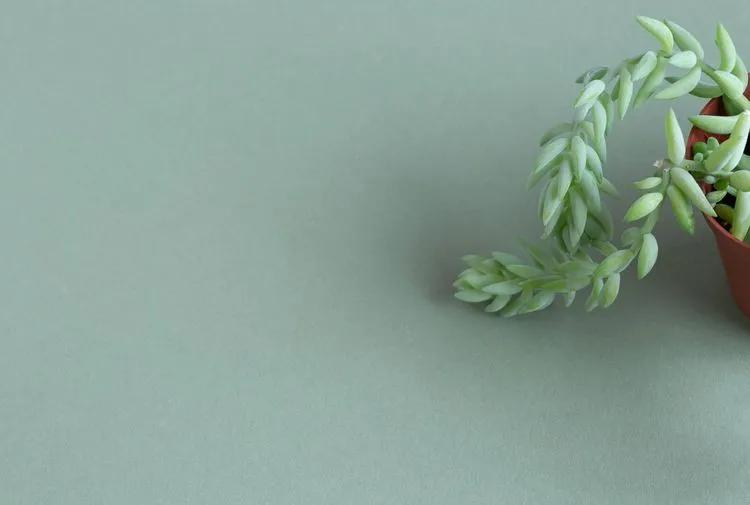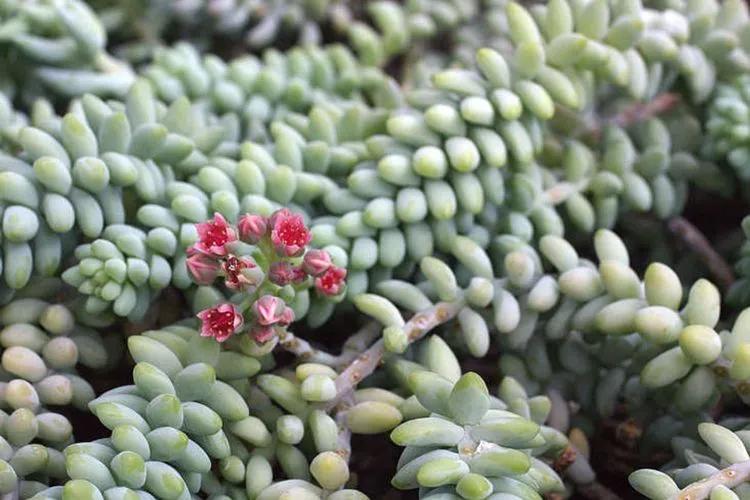Looking for a pretty but easy-to-care hanging plant to place in a pot under the ceiling? Pay attention to burro’s tail, a hardy light-green cute succulent which blooms with tinty star-shaped flowers. Sounds promising, right? Let’s discover all its characteristics and care preferences.
Basics
 Sedum or morgan sedum (lat. Sedum morganianum) is a representative of the genus of succulents from the Crassulaceae family, which, according to various sources, numbers from 350 to 600 species. From Latin, Sedum morganianum in translated as soothing, the name "sedum" appeared due to the healing and cleansing properties of the plant. Hanging donkey tail plants are spread all around America and Mexico.
Sedum or morgan sedum (lat. Sedum morganianum) is a representative of the genus of succulents from the Crassulaceae family, which, according to various sources, numbers from 350 to 600 species. From Latin, Sedum morganianum in translated as soothing, the name "sedum" appeared due to the healing and cleansing properties of the plant. Hanging donkey tail plants are spread all around America and Mexico.
This herbaceous perennial plant has unusual fleshy cone-shaped leaves, which resemble the grapes. The leaves are arranged quite tightly and closely nestle against each other and against the stem. The leaf plant is about 2 cm in length, and the width is up to 0.5 cm. Densely leafy shoots. Due to the unusual hanging stems, sedum has several common names such as donkey tail plant or burro’s tail plant.
The flowers are axillary, actinomorphic, stellate, with lanceolate petals, collected in racemose or corymbose inflorescences. The flowers are pink-red. A flower 2 cm in diameter contains about 5 - 6 petals. They are organized in small axillary inflorescences. Donkey tail plant care is not as complex as you might think by looking at this exotic cutie. Even beginner plant parents can grow this pretty succulent.
Watering
In the summer, the plant needs moderate, but regular watering after the topsoil dries up to 1.5 cm in depth. With insufficient watering, the leaves wrinkle and fall off. Excessive moisture can cause rotting and death of the plant.
The morgan sedum develops best in a room with a low humidity level. Spaying is not needed; however, you can mist it occasionally to remove dust. It is unadvisable to wash off the dirt with the intense water pressure as the leaves can be damaged, and they will begin to crumble.
Lighting
Burro’s tail is a light-loving plant. Therefore, the succulent is best positioned on the south side of the house to absorb direct sunlight. If this is not possible, it is better to organize additional artificial lighting for the plant. For example, install a photo lamp with a minimum of ten-hour lighting support during the day. In case of a lack of illumination, the sedum will not bloom or might lose its leaves.
Temperature
 To maintain burro’s tail succulents in good condition, regulate the temperature regime in the room. For summer, the optimum temperature is in the range of 75.2-82.4°F (24-28°C). It loves fresh air, so in summer, you can take it out to the balcony, veranda, or at least ventilate the room. The plant's dormancy period starts in winter; therefore, it needs a cool room with a temperature of 50-64.4°F (10-18°C). Such an environment will slow down the vegetative processes.
To maintain burro’s tail succulents in good condition, regulate the temperature regime in the room. For summer, the optimum temperature is in the range of 75.2-82.4°F (24-28°C). It loves fresh air, so in summer, you can take it out to the balcony, veranda, or at least ventilate the room. The plant's dormancy period starts in winter; therefore, it needs a cool room with a temperature of 50-64.4°F (10-18°C). Such an environment will slow down the vegetative processes.
Soil
It is advisable to fill the flowerpots with a primer intended for cacti or succulents. In this soil composition, the main component is peat, supplemented by limestone and dolomite flour. Experts recommend using low-lying heavy peat, which will help to lighten sand and expand clay. Due to its root system, choosing a wide and flat pot is better for its lifespan. At the bottom of the pot, it is necessary to make high-quality drainage from expanded clay.
FAQ
undefined
How to propagate donkey tail plant?
To obtain new plants, experts recommend using the following burro's tail propagation methods:
-
Cutting is a popular technique that can only be used before or after flowering. The work's technology consists of separating the required number of cuttings from the mother bush, the optimal length of which is 10 cm. Small burro’s tail can be planted only with the appearance of the roots.
-
Dividing a bush is the simplest way of reproduction, which involves dividing the mother bush into the required number of parts. A prerequisite is the presence of both roots and buds on each piece.
-
At home, the seed propagation method is seldom used. However, if you want to try, you must adhere to the basic rules: you need to plant seeds in a container, cover it with a cling film, and provide needed lighting. Planting seeds should be done in spring or early fall.
When does burro’s tail flower?
The plant blooms extremely rarely, and only well-groomed plants can delight their owners with the flowering. But if you are fortunate and have created ideal conditions, the donkey tail plant will bloom from April to June.
The inflorescences of pink-red, occasionally purple, flowers appear at the stems' ends, reaching 2 cm in diameter. There are up to 10 flowers in the inflorescences, which open alternately, ensuring the duration of flowering. When closed, the buds look like tulips; then, they develop into five-pointed star-like flowers with yellow stamens.
What happens when you touch burro’s tail and touch your face?
 Questioning yourself is the donkey tail plant poisonous? In some cases, getting juice into the stomach or mucous membranes can cause indigestion, weakness, and severe vomiting. So yes, it is poisonous.
For safety reasons, if you have children or animals, ensure that the flower pot is out of their reach to avoid unpleasant consequences.
Questioning yourself is the donkey tail plant poisonous? In some cases, getting juice into the stomach or mucous membranes can cause indigestion, weakness, and severe vomiting. So yes, it is poisonous.
For safety reasons, if you have children or animals, ensure that the flower pot is out of their reach to avoid unpleasant consequences.
Burro’s tail care is not hard to follow, and with proper conditions, you will be please with its exotic look in your home for many years. Hust remember that this cutie loves being in the spotlight: provide it with bright direct light.
